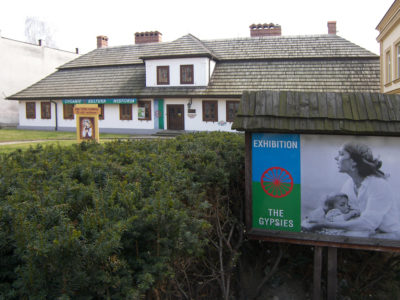Tarnów region surprises with unique places that create specific atmosphere of the eastern part of Malopolska. Each nationality and culture that had lived in Tarnów area throughout the centuries has succeeded in leaving its own unique mark on the city evident in both structures and traditions. The charm of these places makes people come back over and over again. Fascinating world of local traditions and reviving folk art are no longer the domain of older people but attract younger who search for their identity, their roots.
Unification of culture as a result of globalization changed young generation’s perception of folklore. Wearing ethnic outfit is no longer passe. Joined in a celebration of local traditions young people redefine their identity acknowledging the wisdom of their ancestors.


Zalipie – North of Tarnów, where Dunajec and Vistula rivers meet, resides one of the most interesting ethnographic micro-regions in Poland with the village of Zalipie at its center. Its fame has resulted from a region specific tradition that involves the painting of cottages. This custom of decorating both the exterior and the interior of houses originated at the end of the 19th century when old-fashioned furnaces were replaced with new furnaces with chimneys. In order to cover blackened walls, women and girls tried to brighten the interior of their dwellings by decorating the walls with brightly colored spots made of lime. Later these round spots were shaped into simple flowers and finally they evolved into the detailed flower bouquets still visible today.

Using flower compositions, the women put special emphasis on decorating the wide stoves. Also, they painted flower garlands under pictures and around windows and doors. At a later period they began to paint the exterior of their homes. Initially, the ornamentation was predominantly geometric with dots, curves, circles, zig-zags, and wavy lines etc. and the materials used were simply those that were most available like brown clay, soot, and lime. As an adhesive they used milk, sugar and egg whites or dumpling stock. Women painted with brushes composed of horse hair, leather, or human hair; some of these types of brushes were still used up until a several years ago.
This art form was not recognized until the year 1905 when a clerk from Krakow, Władysław Hickel, was intrigued by the one-of-a-kind Zalipian cottages and became the first journalist to publish an article about them in “Lud,” an ethnographic periodical. In the period before WWII ethnographic interest in the phenomenon caused the creation of the Zalipian display in the Ethnographic Museum in Krakow. After the war this form of folk art started to disappear, until through efforts of ethnographers it was reborn.
Contests in house-painting started in 1948 and occurred every few years until 1965 when it became an annual event. In addition to Zalipie, these special cottages can be found in a number of surrounding villages. Despite that, Zalipie remains the most popular as home of Felicja Curyłowa (1904-1974), one of the greatest folk painters. Still today Zalipie is the village that maintains the largest amount of painted houses, numbering more than twenty. Single cottages can be found in Ćwikow, Kłyż, Kuzie, Niwki, Podlipie and Samocice, however the paintings in these villages are much more simple and archaic than those in Zalipie.

The talents of local artists are not limited to wall paintings alone, as they create embroidered and painted furniture coverings, ornamented table clothes, aprons, china, glass etc. Souvenirs are available for tourists at “Dom Malarek” Cultural Center. Unfortunately, it may be difficult for tourists to find painted houses because the village is very spread out and the decorated structures are far from the main road. Additionally those are not exhibits but real homes. The only object opened to the public is Felicja Curyłowa’s farmstead, actual branch of the Regional Museum in Tarnów.
Not only homes, the art was practiced on Zalipie church as well. The building appears as common country church except for its exterior, which was decorated by the local women. Also, the local school and other public structures are traditionally painted. In order to celebrate and expand upon this unique folk art, Tarnów Ethnographic Museum organizes annual contest called “Painted Cottage” which is the best opportunity to see local artists at work. The contest takes place in the spring immediately after Corpus Christi holiday.

The Tarnów Ethnographic Museum , located in former suburban inn, which is now in the very center of the city, displays the only permanent exhibition of Gypsy history and culture in Europe. A large collection of clothes, tools and other utilities can be seen there. However the most impressive units are five original horse carriages parked in the backyard.
Lipnica Murowana , small village with unchanged medieval urban layout, is well known in whole Poland. Each year hundreds of participants compete in the traditional Easter Palm Contest. Winning palms reach up to 35 meters into the sky.
Bobowa is one of the oldest settlements in the Biała River Valley, famous for its rich folklore and extraordinary handicraft. The women of Bobowa practice the art of creating intricate lace designs for centuries; each year on the first week of October the International Lace Festival takes place here. However, no other place in Poland can match the extensive work of the women of Bobowa.
Agrotourism. Whether it is summer or winter brake both – individuals and families can enjoy the legendary Polish hospitality. There are over 200 farms in the Tarnów region offering accommodation, organic food and recreation activities of unique values. Mushroom picking, fishing, horse-riding in the summer, skiing, horse-sledge rides in the winter and sightseeing all year round. There is plenty to choose from and all that at very competitive prices. Some farmers allow tourists to participate in an every-day activities, such as: feeding the animals, weed or harvesting.